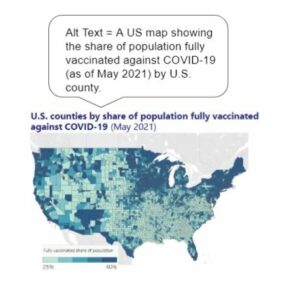Whether you’re a marketing specialist, social media influencer, or university professor, it’s essential to understand the basics of alternate text (alt text) for accessibility. Read on for the top 7 best practices that will change how your content is read and understood in an accessible way.
What is alternate text and why does it matter?
Before diving into these tips for success, let’s quickly define what we are talking about.
Alternate text is also known as alt text or accessible text. It is dedicated content allowing readers and viewers who are visually impaired or have other accessibility needs to read and understand images, language, and other online multimedia and documents. Alternate text also describes multimedia in terms that are conducive to people who cannot view the image for any other reason, such as a learning disability, issues with sensory overload, or individuals who simply can’t load website images. Accessibility also means that anyone may view and comprehend files and media from
anywhere. That’s the goal.
So how do you achieve this? It takes attention to detail, consideration for all content types, and a basic understanding of search engine optimization (SEO). Here are 7 tips to get you on the right path.
Being concise is everything.

It’s imperative to incorporate concise and distinct language when describing all images and form image buttons. Make sure the terms are relevant, appropriate, and succinct…especially to meet 508 compliance standards. Though many individuals would prefer to add numerous details and descriptions that may seem to enhance the viewer’s experience, it will not breed an environment friendly to accessibility. This is due to several reasons:
- Alternate text that keeps things simple is easily digestible for the viewer.
- Generalizations and false assumptions could come into play when creating more prolonged and detailed descriptions.
- Keeping content under 125 characters (250 to meet 508 compliance standards) better ensures viewers will see the complete information.
You’re not the only one who knows it is alt text.
When talking about an image, steer clear of literally saying it’s a photo. In other words, saying something like “picture of a horse eating a carrot” is not the way you want to go. Instead, drop the “picture of” and keep “horse eating a carrot.”
Why? Because it’s easy to distinguish alt text from other text (whether it’s a computer or a human being). It’s more concise, and less annoying, frankly, to keep things short and sweet.
Say no to keyword stuffing.
Whether you’re a seasoned SEO expert or a novice, it’s common knowledge that keywords are an essential component of building a website. But avoid using too many. Otherwise, Google (or any other search engine) will know and hurt your site’s relevance in searches.
Don’t do this for decorative images.
Images that do not convey content are decorative. It’s best not to waste anyone’s time by describing these images, or alternatively, explaining content that is already stated in the text. When in doubt, ask yourself this question: Will readers better understand this webpage or file if I incorporate alternate text? If the answer is yes, it’s probably not a decorative image.
Complex images need a bit more attention.
Equivalent alternatives to complex images (e.g., flow charts, graphs, maps) should be provided with context or linked on a separate page.
Without repeating, include words incorporated in the image.
Images of, or that include text (e.g., logos) should have the text as part of the description. Always do this unless the information has already been stated (e.g., it’s written in the heading).
Consider animated media and mathematical formulas.
Animation can cause issues for people who have trouble focusing or those vulnerable to seizures. This type of media should have an alternative option or be described in text. Similarly, math formulas and equations should also either have alternatives or be provided in text.
If you follow these best practices, your content will get the accessibility boost you and the public deserve as well as meet 508 compliance standards. Visit digitalecho.io/508-compliance-pdf-accessibility-services for more information.

Comments are closed.